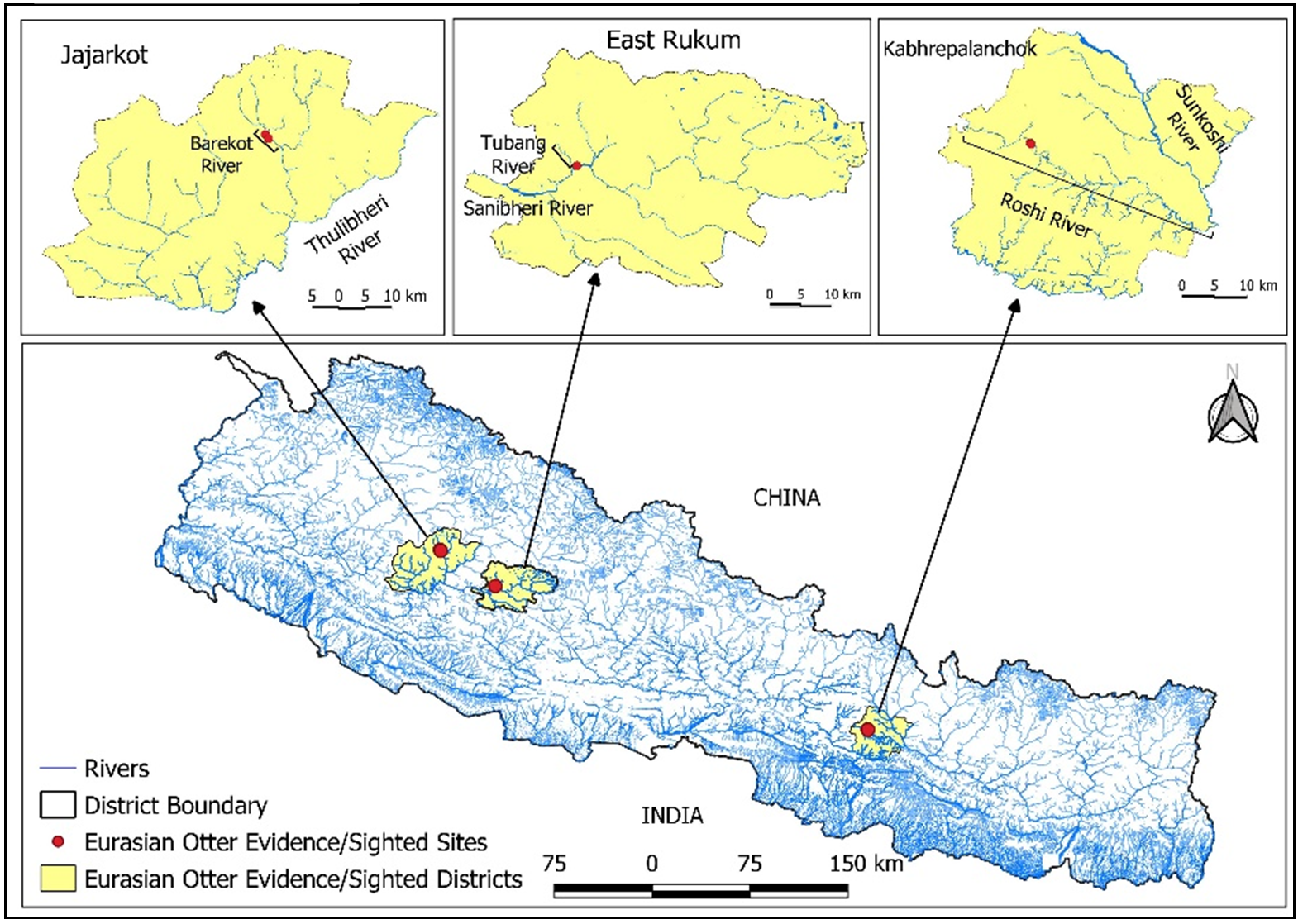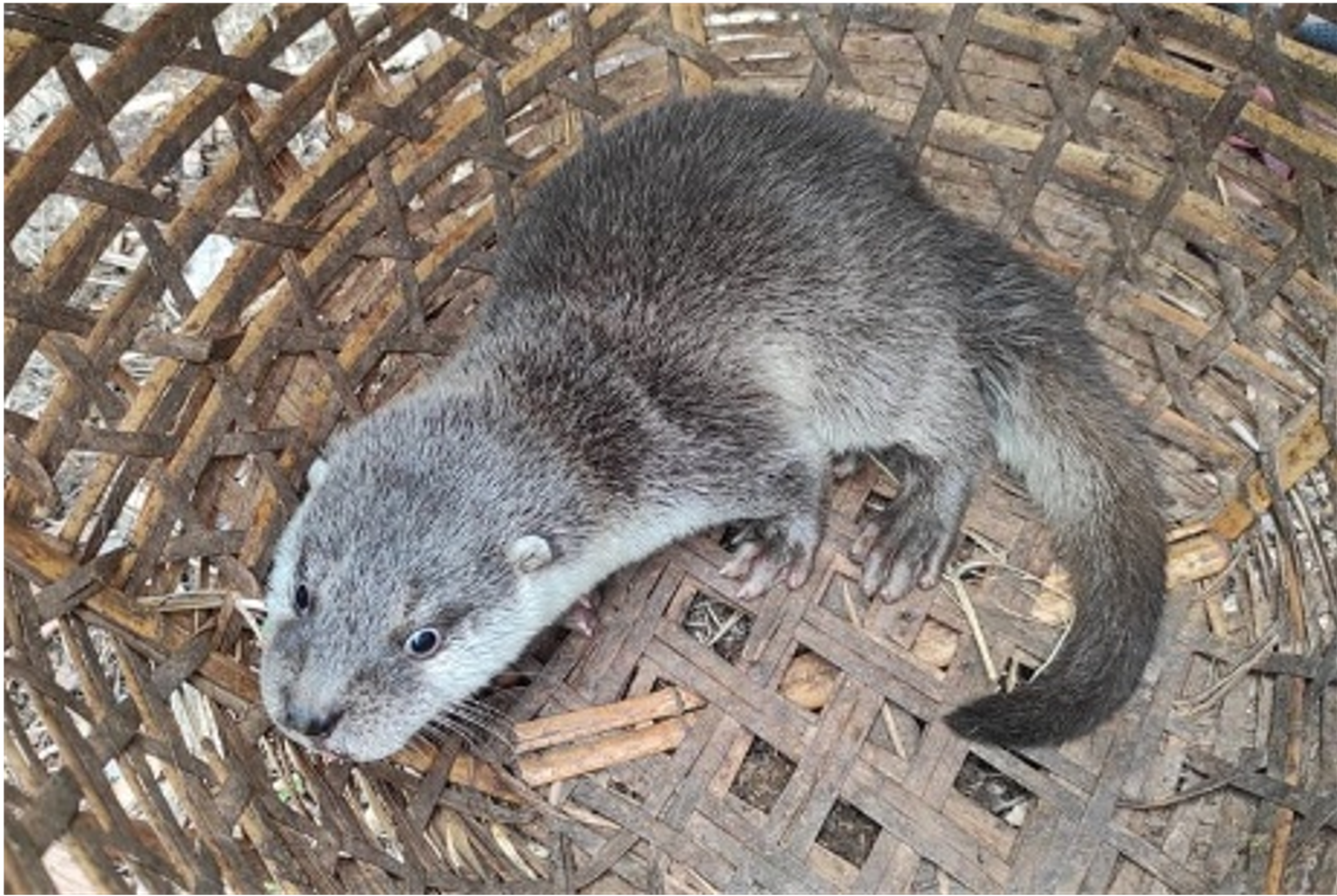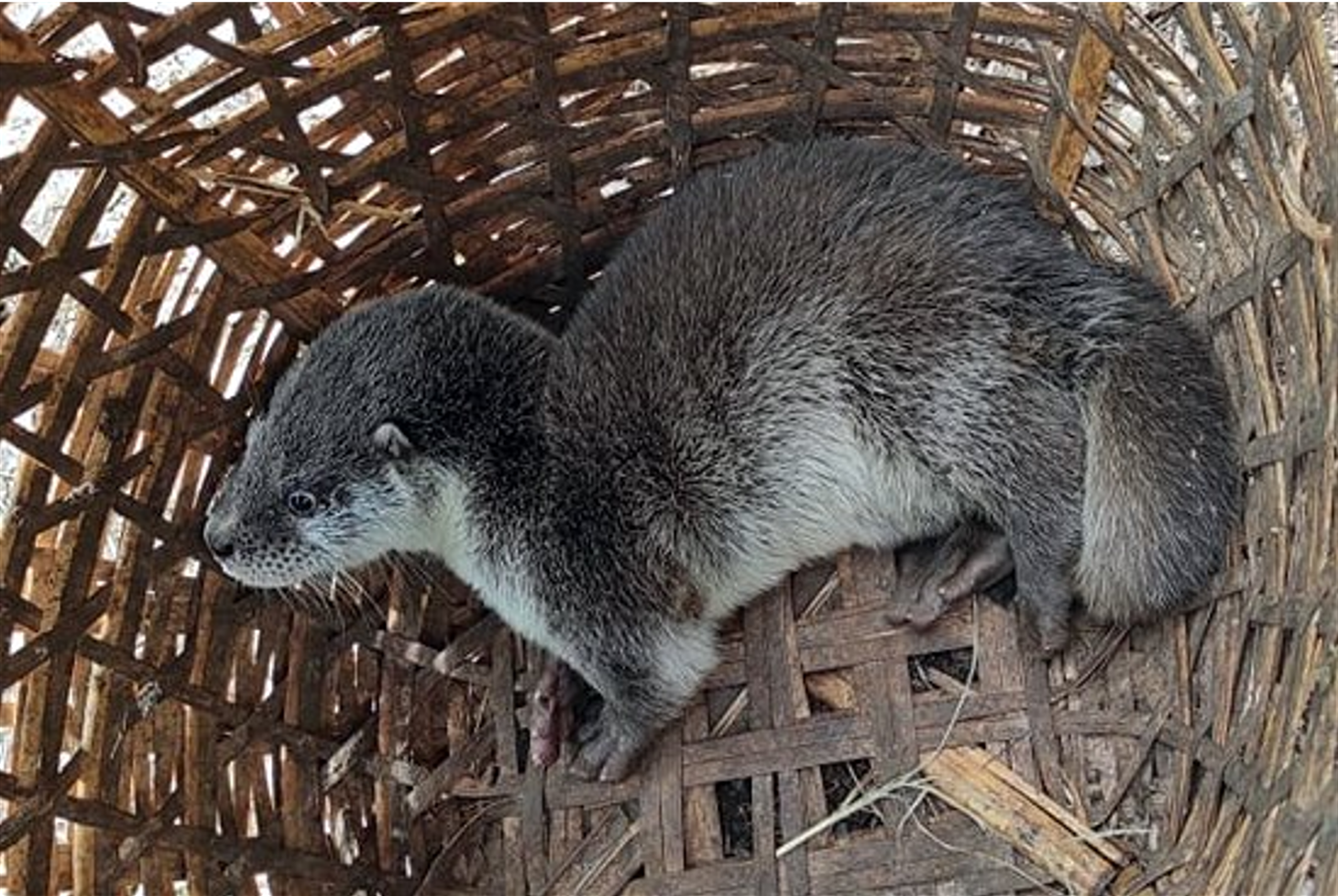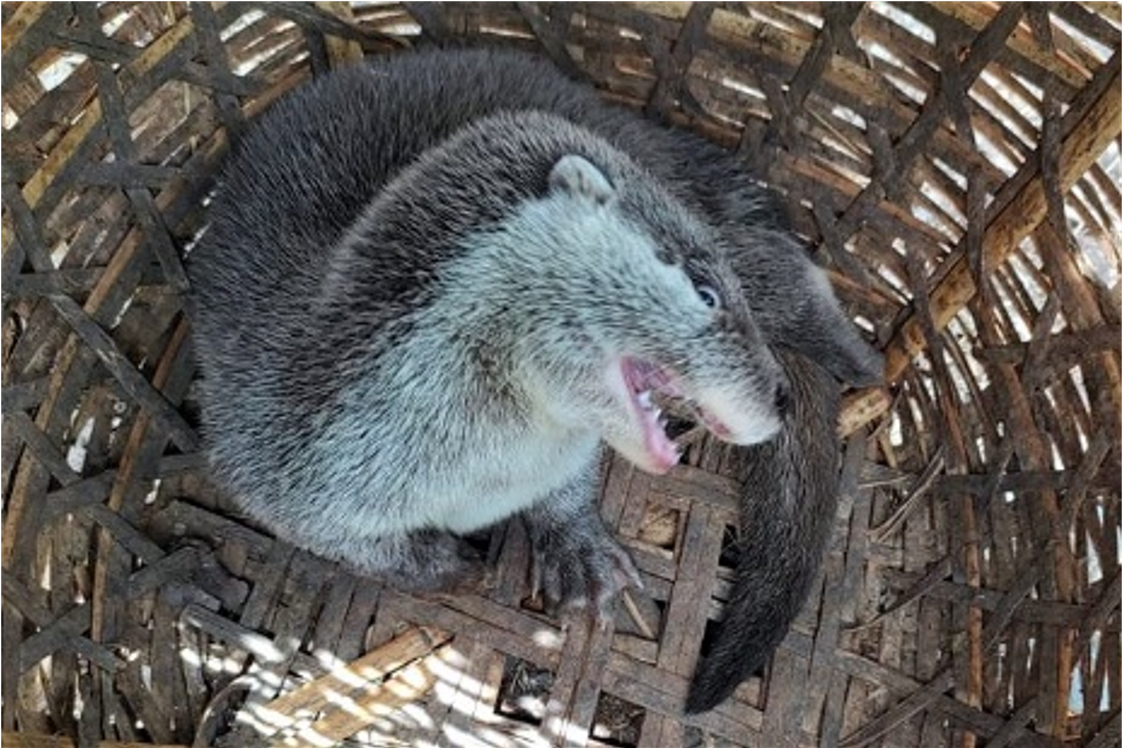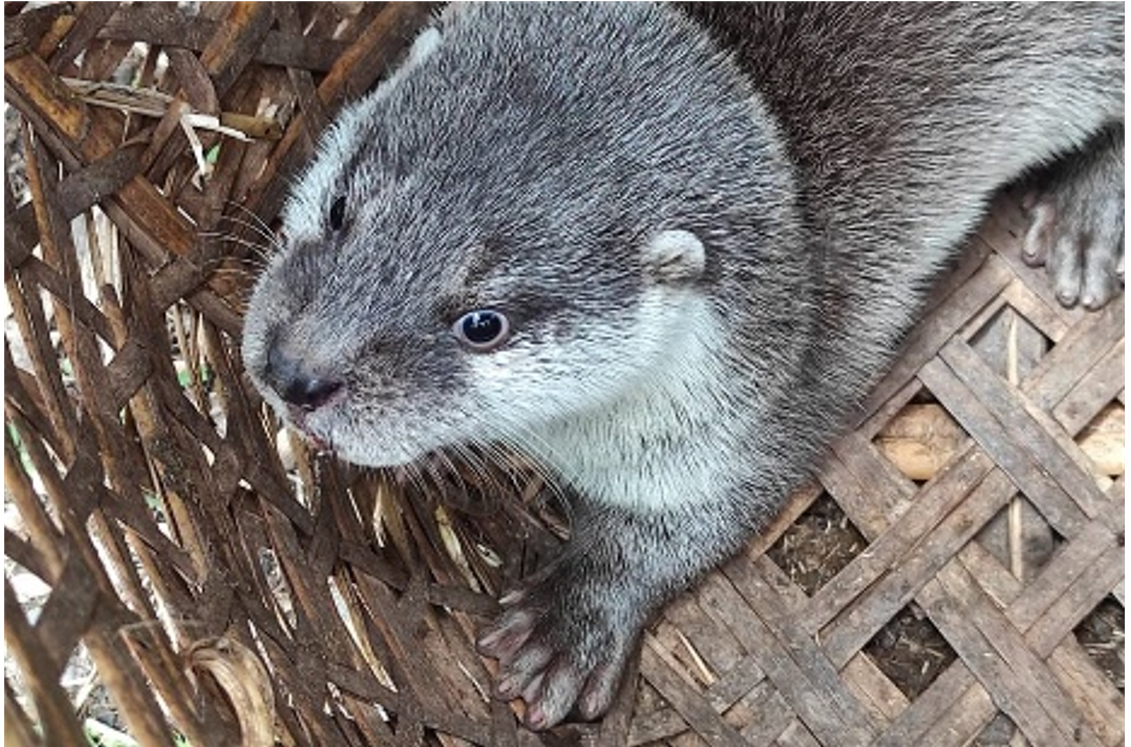IUCN/SSC Otter Specialist Group Bulletin

©IUCN/SCC Otter Specialist Group
Volume 38 Issue 5 (December 2021)
Citation: Shrestha, M.B., Shrestha, G., Reule, S., Oli, S., Ghartimagar, T.B., Singh, G., Tripathi, D.M., Law, C.J., Shah, K.B., and Savage, M. (2021). First Evidence of Eurasian Otter in Nepal in Three Decades IUCN Otter Spec. Group Bull. 38 (5): 279 - 291
First Evidence of Eurasian Otter in Nepal in Three Decades
Mohan Bikram Shrestha1*, Ganga Shrestha1,2, Swabhiman Reule1, Sundar Oli1, Tek Bahadur Ghartimagar1, Govinda Singh3, Devesh Mani Tripathi4, Chris J. Law5, Karan Bahadur Shah6, and Melissa Savage7
1 Wildlife Research & Education Network, Nepal Email: shrmohan5@gmail.com
2 Central Department of Environmental Science-Tribhuvan University, Nepal
2Barekot Rural Municipality, Jajarkot
4Department of Forest and Soil Conservation, Nepal
5American Museum of Natural History, New York, USA
6Natural History Museum, Tribhuvan University
7University of California, Los Angeles, USA
*Corresponding Author
(Received 10th April 2021, accepted 4th July 2021)
Abstract: This study presents the first evidence of Eurasian otter presence in Nepal since 1991. Camera trap images from the Barekot River in Jajarkot District, photographic images from Tubang River in East Rukum District evidence and the skull of a dead otter are presented as documentation. Twelve craniomandibular traits measurements were carried out on a skull specimen found in the Roshi River: condylobasal length (CBL) of the cranium, measured at 111 mm, and zygomatic breadth (ZB) at 66 mm, identify the specimen as a Eurasian otter (Lutra lutra). CBL and ZB measurements, flat shaped skull and longer rostrum were similar to those obtained by morphometric studies of Eurasian otter in other parts of its range.
Keywords: Eurasian otter, Barekot River, Tubang River, Roshi River, craniomandibular traits, Nepal
INTRODUCTION
The Eurasian otter (Lutra lutra) has been anecdotally reported in mountain streams and rivers across Nepal. Presence of Eurasian otter was reported from Rara Lake (Bolton, 1976) and both Rupa and Begnas Lakes with photographic evidence (Acharya and Gurung, 1994), but a study in 2008 (Bhandari and Bijaya, 2008) and later in 2018 found no otter presence in those lakes (Basnet et al., 2020). Anecdotally the presence of Eurasian otter was suggested in protected areas such as the Annapurna Conservation Area, Makalu Braun National Park, Bardia National Park, Rara National Park and outside protected areas in Saptari, Chitwan, Kapilvastu, Bardia, Kailali, Kanchanpur, Bajhang, Bajura, Ilam, Panchthar, Taplejung and Sankhuwasabha Districts (Biodiversity Project Profile, 1996); from the Kanchenjunga region (Yonzon, 1996); from 8 districts in the Terai and 13 districts in the hilly region (Shrestha, 1997); from West Seti River (Yonzon, 1998); from Ghodaghodi Lake of Kailali District (Kafle, 2007); and from streams and streamlets in Pyaudikhola watershed and Kapringkhola watershed of Gorkha District (Kafle, 2011). However, these presence reports are based on indirect signs and through the public reports without verifiable evidence (Basnet et al., 2020).
Anthropogenic disturbances; natural habitat degradation, sand and stone extraction from rivers, overfishing, shoreline vegetation removal, livestock grazing, irrigation canal and dam construction, frequent human activity on river bank, industrial and agricultural pollution are the causes led the decline in Eurasian otter in Nepal (Acharya and Lamsal, 2010; Acharya and Rajbhandari, 2011). The seizure of 755 skins between 1989 to 2017 may indicate that the illegal pelt trade threatens otters in Nepal, although the seizures may largely reflect transit of the pelts from India to China (Savage and Shrestha, 2018). Retaliatory killing for predation on fishes in fish farm is a factor behind extirpation of Eurasian otter in Rupa and Begnas Lakes (Bhandari and G.C, 2008). The only and last photographic evidences of Eurasian otter in Nepal by Acharya and Gurung in 1991 was from these lakes (Basnet et al., 2020). We present physical evidence of Eurasian otter presence in Nepal, from the Roshi River, Tubang River and Satichaur River in Nepal.
MATERIALS AND METHOD
Evidence of Eurasian otter was collected from three rivers located in Nepal:
- the Barekot River in Jajarkot District (camera trap images);
- the Tubang River in East Rukum District (photographs); and
- the Roshi River in Kabhrepalanchok District (skull) (Fig. 1).
Barekot River
The Barekot River is located in the Barekot Rural Municipality of Jajarkot District. The Barekot River forms from the confluence of the Muslan River and Daha River which originate in the middle hills, and is joined downstream by the Karkijiula River, the Nalgad River and the Thuli Bheri River. The area has temperate climate with a dry winter and hot summer (Karki et al., 2016). River bank substrate is composed of boulders and large rocks with bank vegetation of Rhus wallichii, Alnus nepalensis, Pyrus pashia, Salix sp., Acorus calamus Berberis asiatica, Arudinaria falcate, Rubus ellipticus, Artemesia indica, Imperita cylindrical, and Urtica doica. Scattered settlements and farms in place of wider river banks prevail in the Barakot River. Two sets of camera trap (Bushnell) were set up in the Barakot River for 72 hours (8-10 June 2021) in two sites about 1200 m apart. Otter images were obtained at Golkhane Bagar (28.954360°N 82.247410°E; 1600 m above sea level (masl) and Satichaur (28.946210 °N 82.253270°E; 1549 masl) (Fig. 2). Eurasian otters were identified from these images by the IUCN Otter Specialist Group.
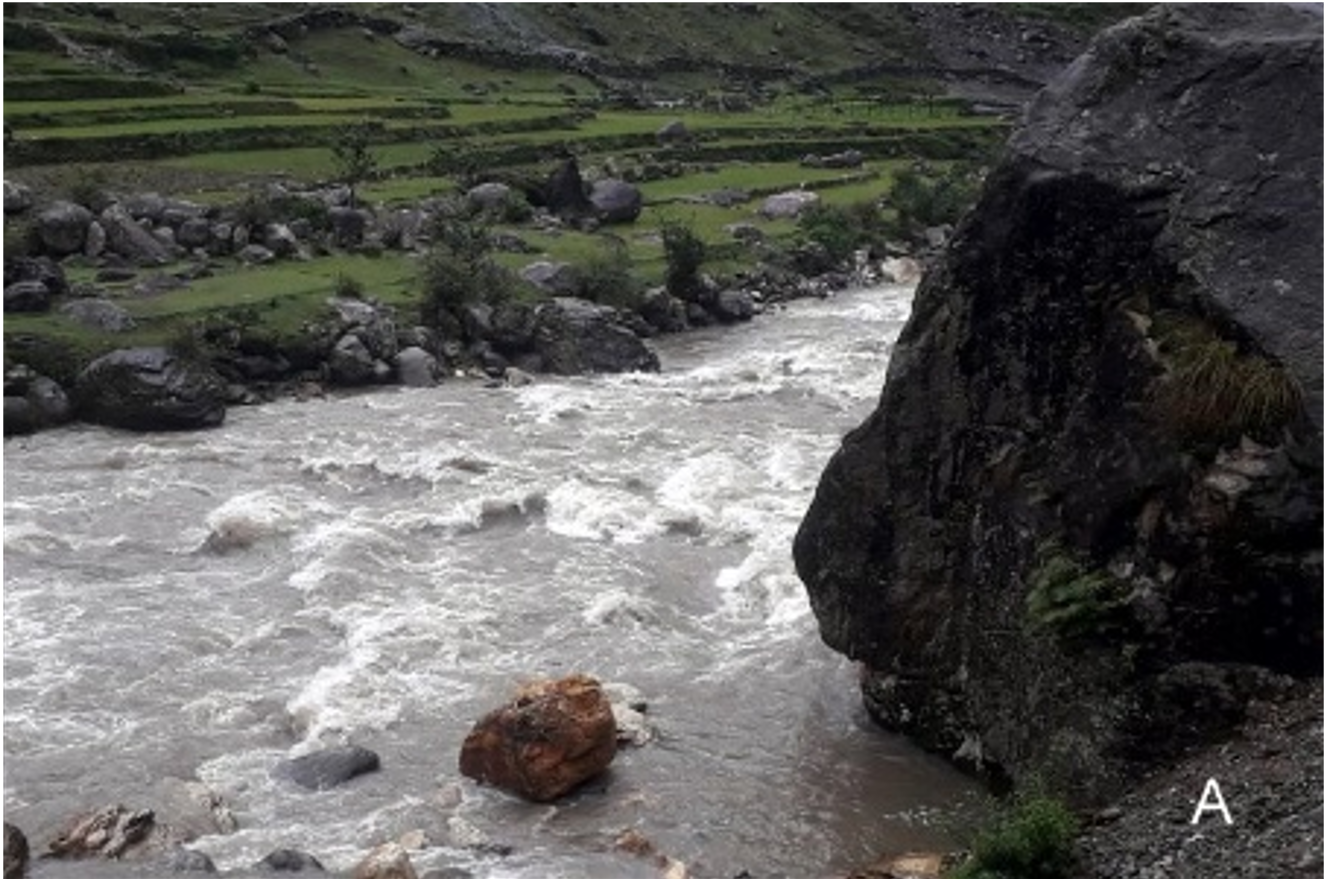
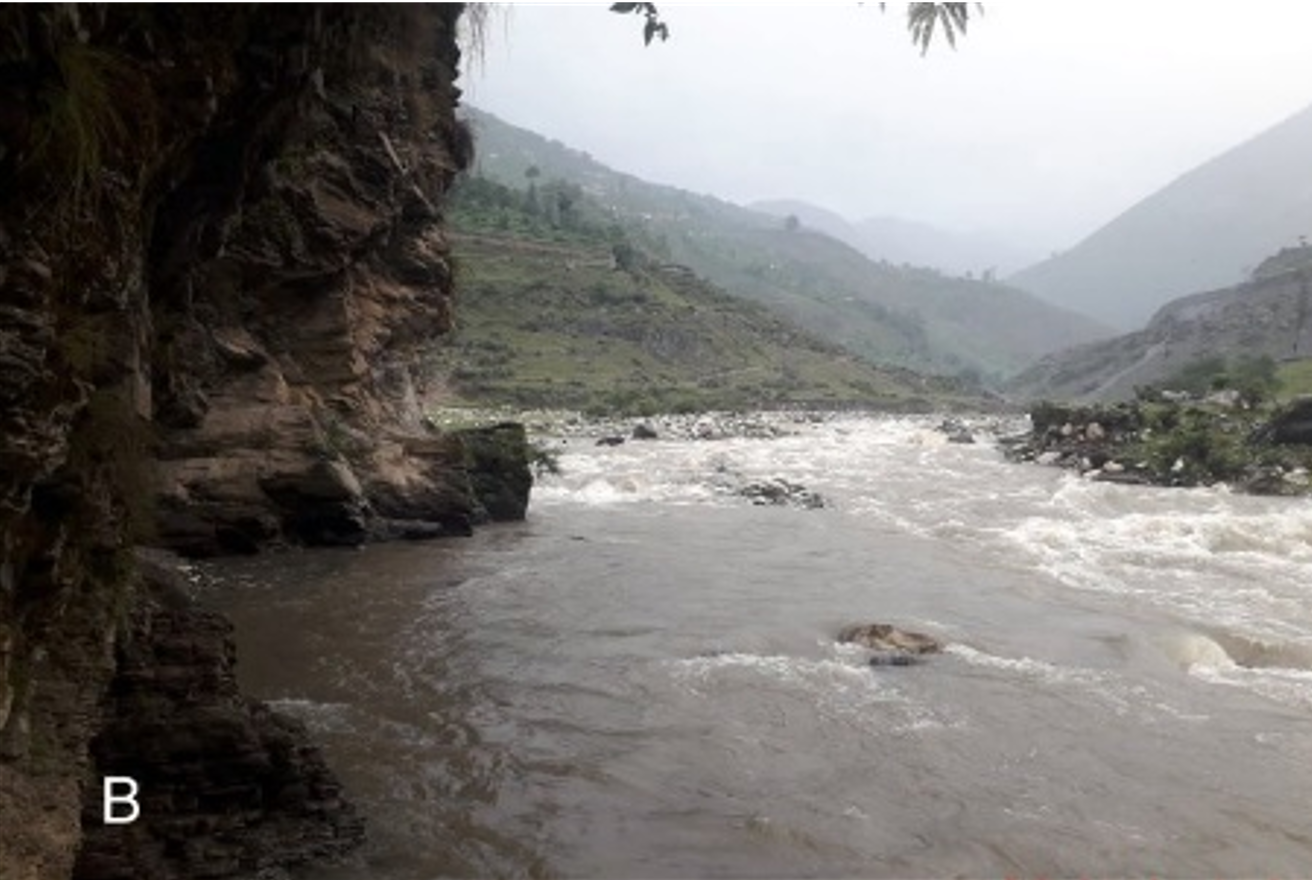
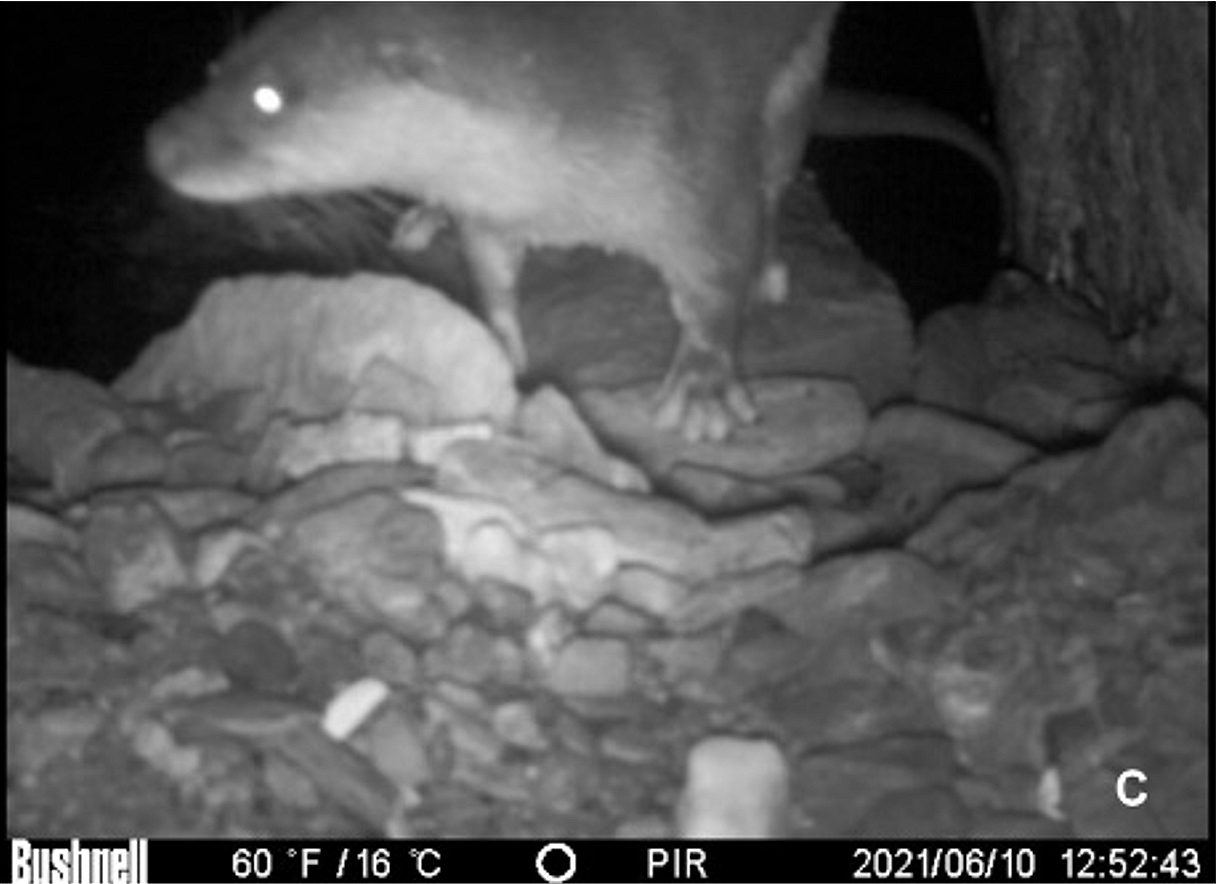
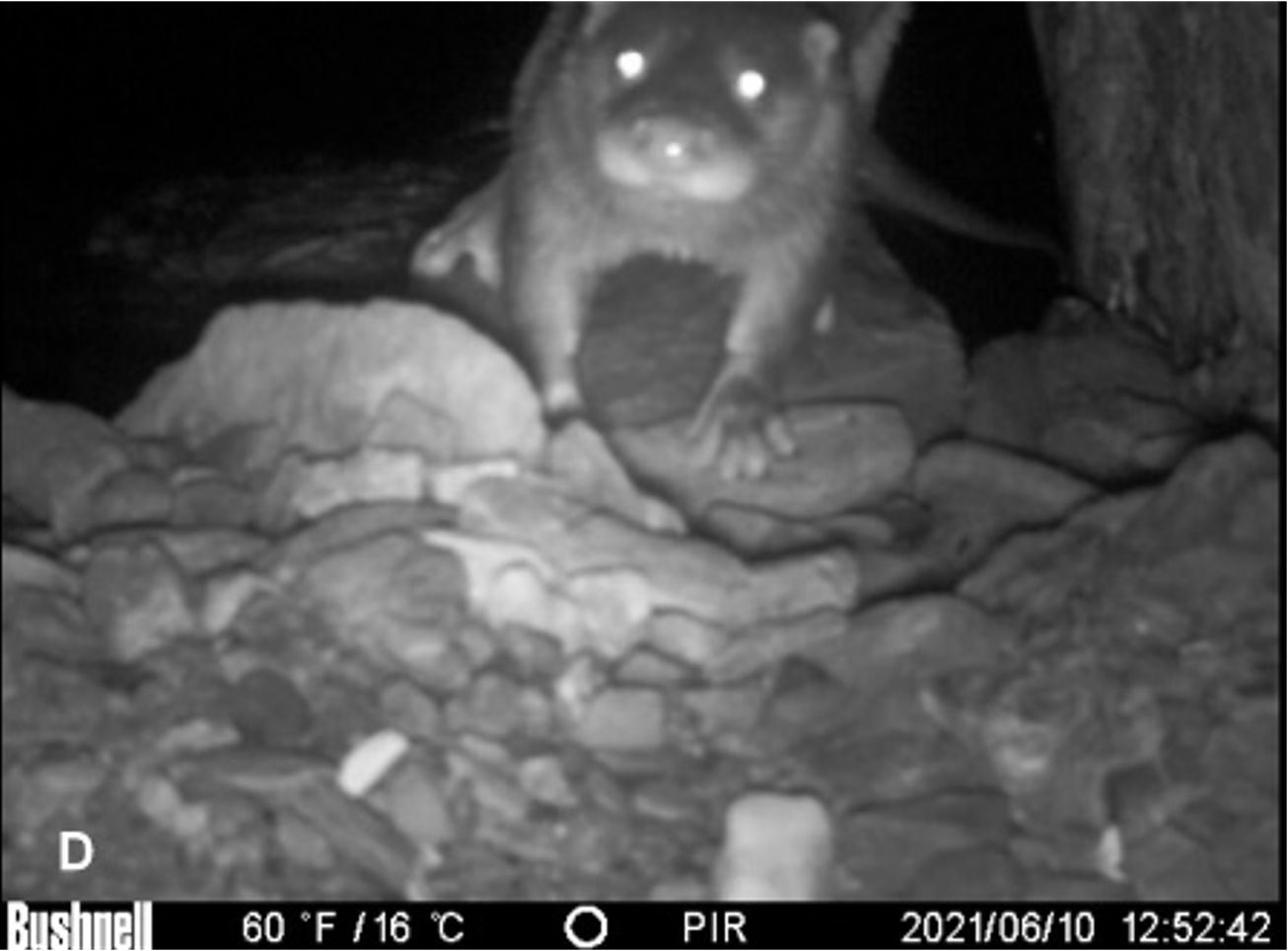
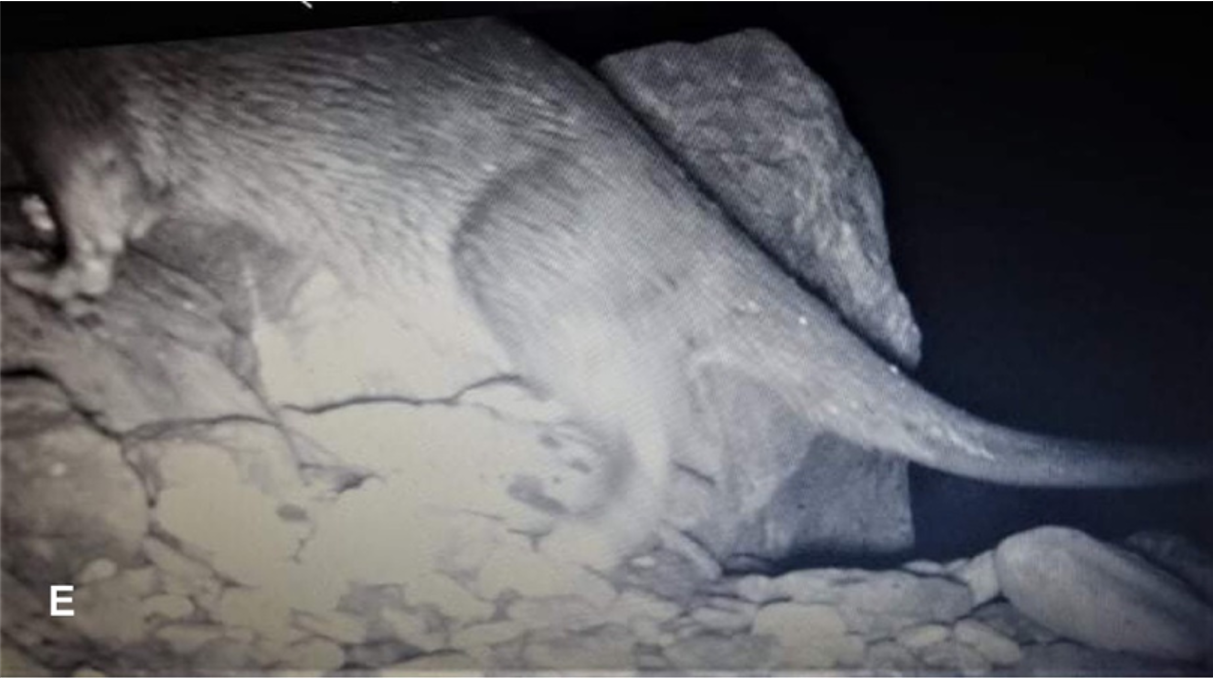
Tubang River
The Tubang River originate in the hills north of Pwang Village in Sisne Rural Municipality that flows southward to a confluence with the Sanibheri River at the Tiptara in Naighad Village. The Tubang River is a small tributary of the Sanibheri River. The water flow during the monsoon season increases, but decreases markedly in the winter season. The area has a temperate climate with dry winters and hot summers (Karki et al., 2016). The river bank is comprised of rock boulders and bank vegetation of Woodifordia fruticosa, Bauhinia variegate, Phyllanthus emblica, Pinus roxburgii, Debregaesia longifolia, Artemesia indica, Imperita cylindrical etc. An injured young otter was captured on 20 June 2021 from the Tubang River (28.675957 82.672678; 1337 masl) about 100 m before the river confluence with the Sanibheri River at the Tiptara in Naighad Village. The otter photographs were identified as Eurasian otter by the IUCN Otter Specialist Group (Fig. 3).
Roshi River
The Roshi River originates in the hills (27.576041°N 85.442487°E; 1900 masl)) at the western border of Kavrepalanchok District and flows through the Panauti Valley to the confluence with the Sunkoshi River downstream (27.450650°N 85.821285°E; 530 masl). The area has a temperate climate with dry winters and warm summers (Karki et al., 2016). River bank species include Alnus nepalensis, Prunus cerasoides, Ziziphus incurve, Woordfordia fruticose, Choerospindias axillaris, Melia azedarch, Albizia procera, Urtica dioica, Bidens pilosa, Adenophora ageratina, Artemesia indica and Ageratum conyzoides. In 2020, a skull of a dead otter was found in duck farmer’s cottage near the Roshi River in the Panauti Suburb area (27.5771510°N 85.530524°E; 1374 masl) (Fig. 4). A single otter scat was also recorded on the boulder in a pool at the location (Fig. 4). Scat was identified by the prey species remnants, fragments of fish and and feather fragments and a fishy odor (Macdonald, 1990; Kruuk, 1995).
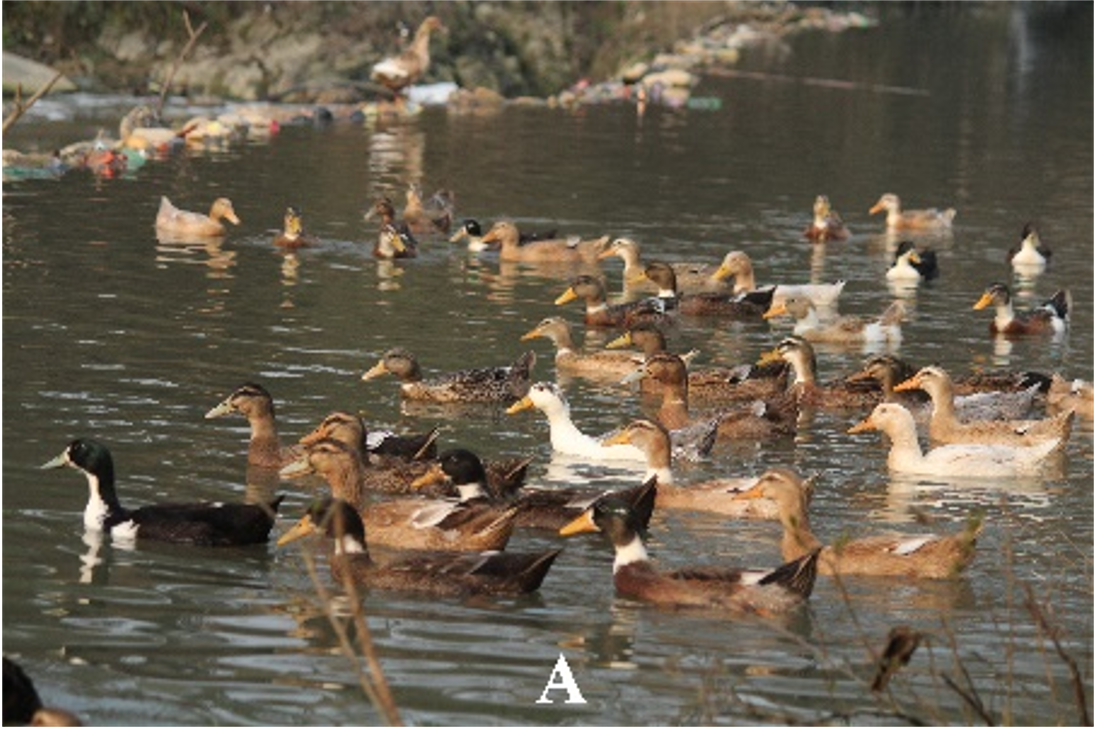
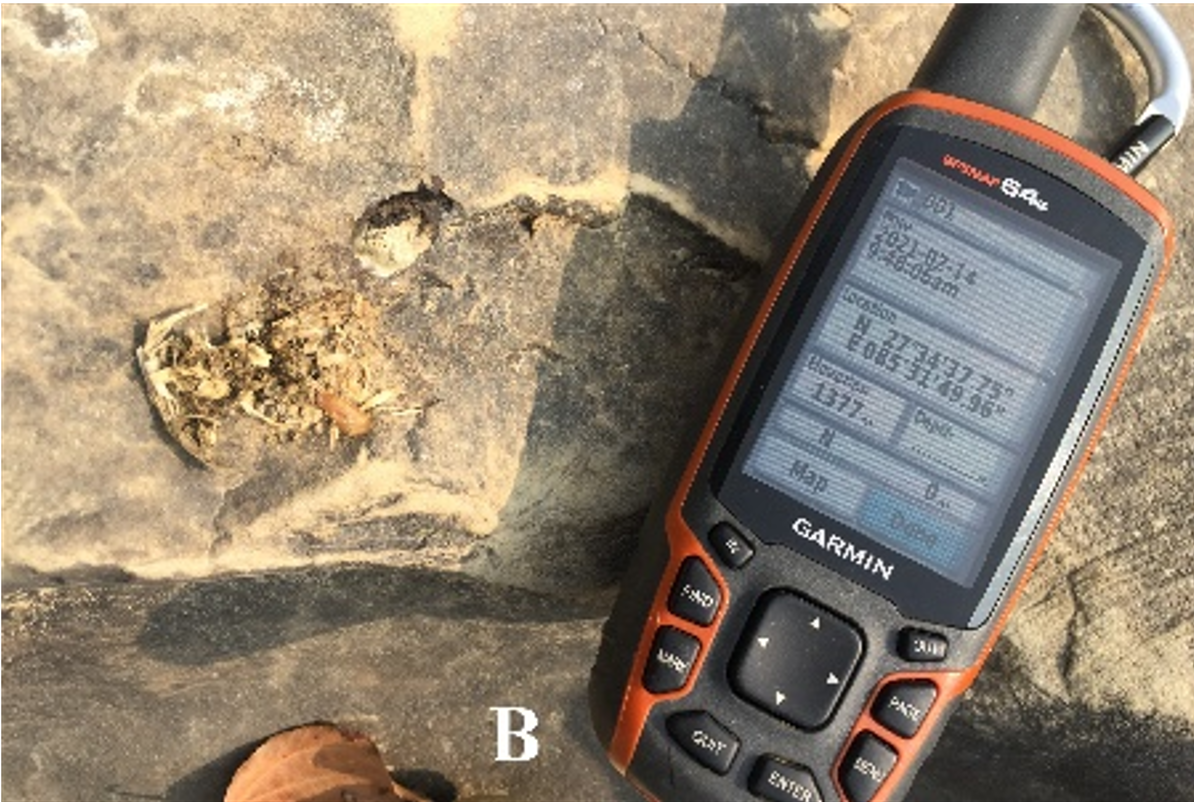
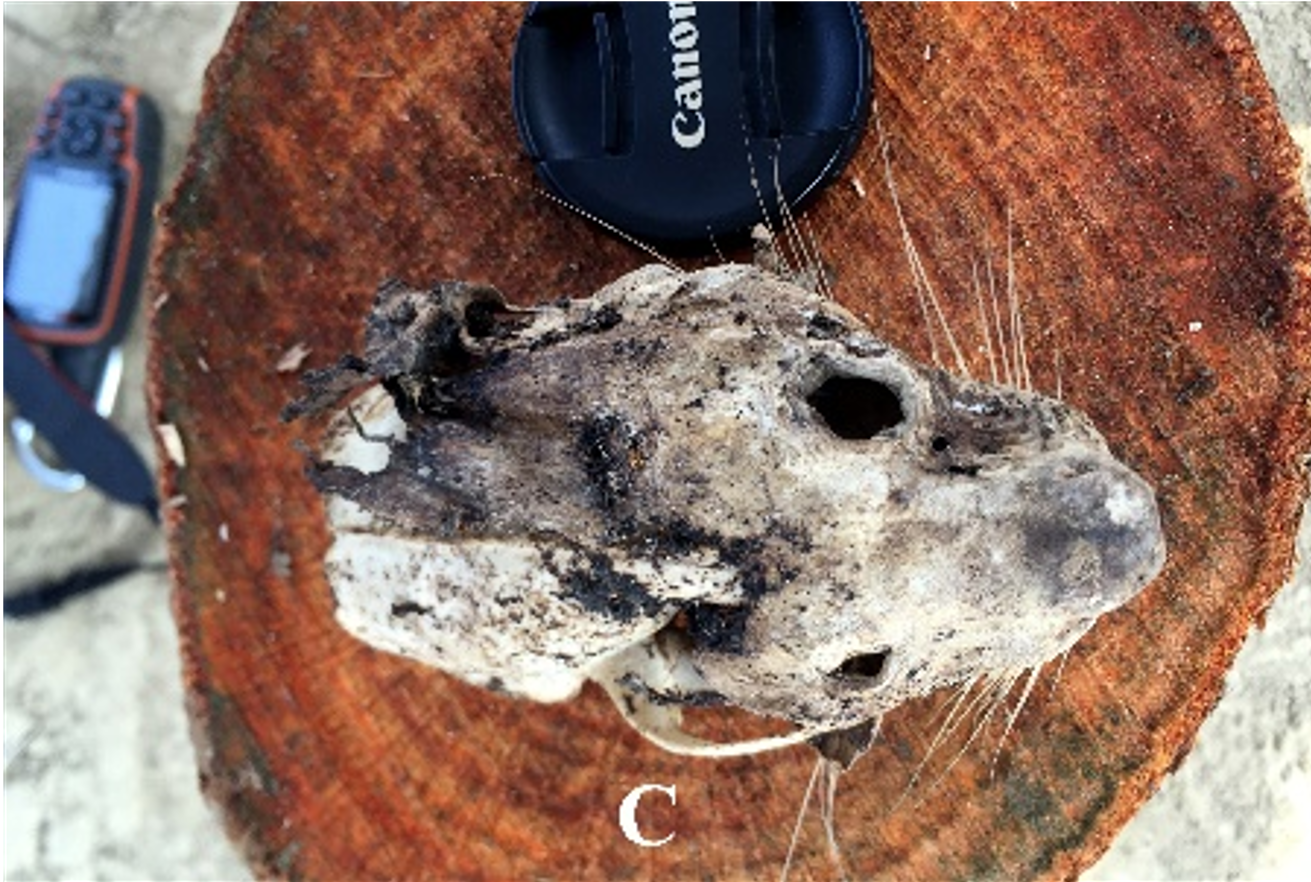
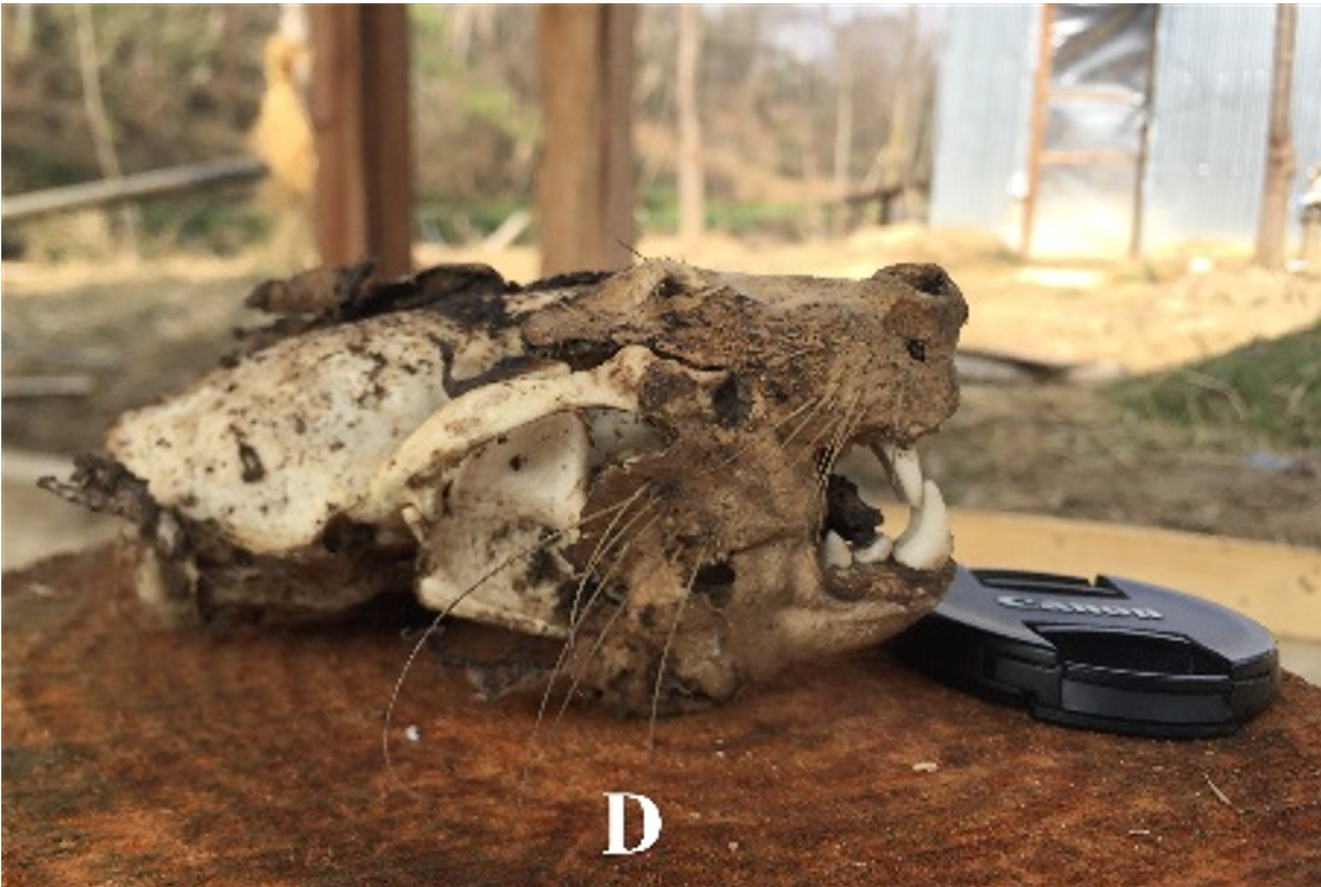
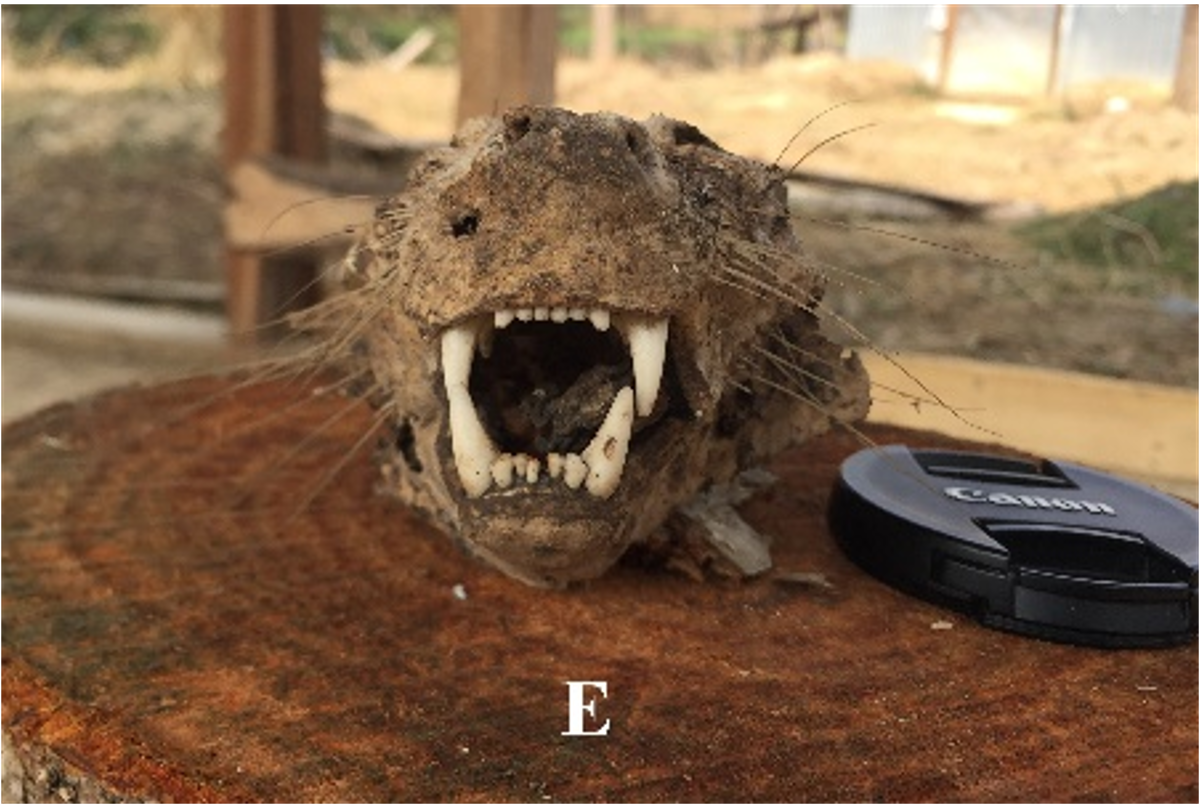
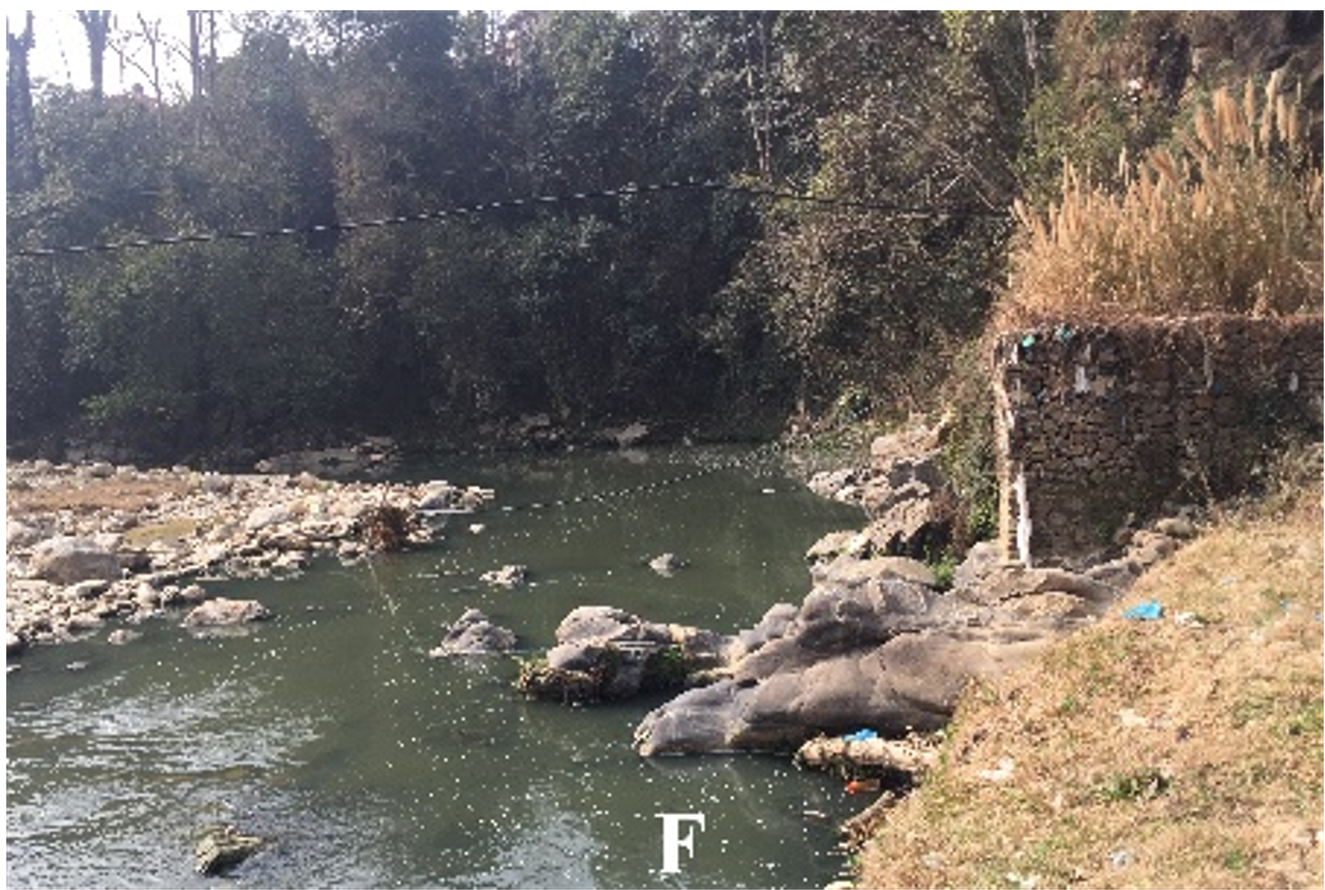
The skull had dried with skin and muscle tissue attached (Fig. 4). We cleaned the tissue from the specimen and took 12 craniomandibular measurements following Law et al. (2016) (Fig. 5; Table 1). The skull was photographed from 4 perspectives: 1) cranium in dorsal view, photographed by orienting the palate plane parallel to the photographic plane; 2) cranium in ventral view, photographed by orienting the palate plane parallel to the photographic plane; 3) cranium in lateral view, photographed by orienting the midsagittal plane parallel to the photographic plane; and 4) mandible in lateral view, photographed by orienting the long axis of the dentary parallel to the photographic plane. Photographs were taken using Canon EOS Kiss X80 with 18-55mm kit lens. A ruler with 1 mm intervals was used for measuring and placed as scale bar.
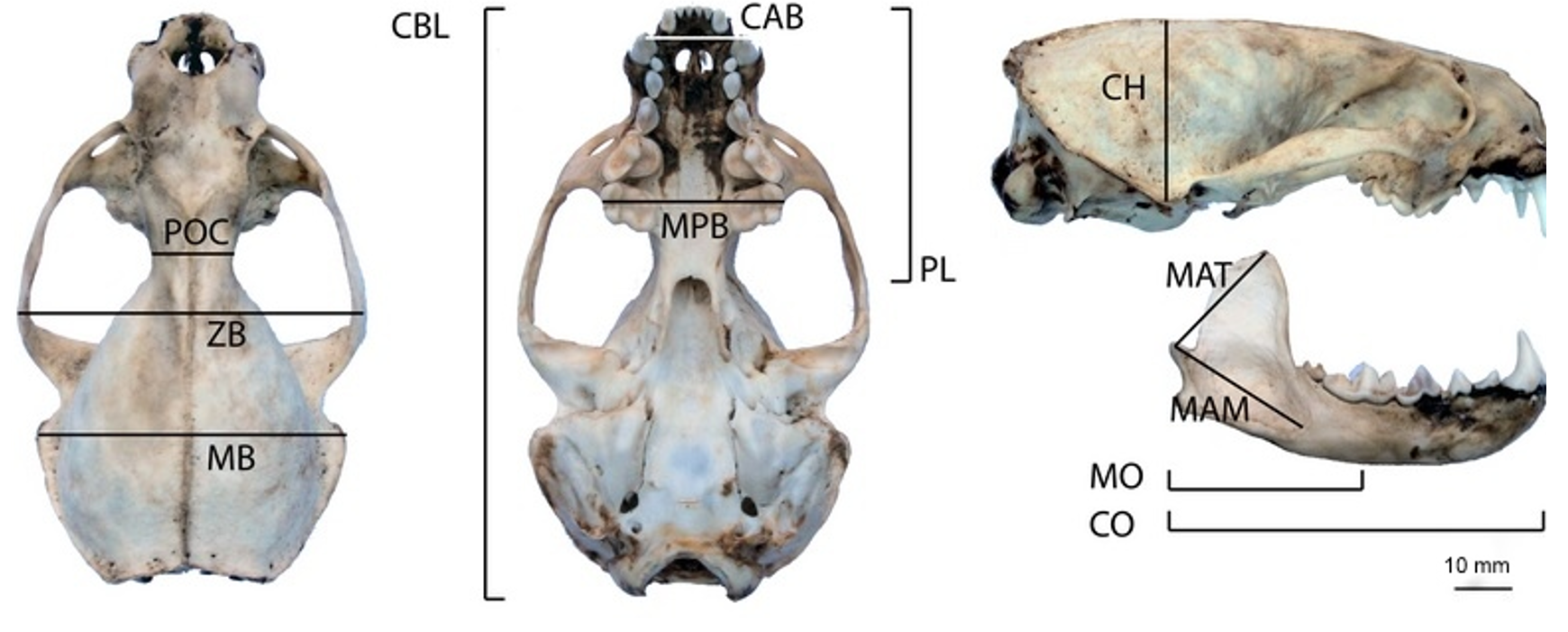
RESULTS AND DISCUSSION
The morphological characteristics of the images confirm the evidence as Eurasian otters: a flattened head; nostrils, eyes and ears in one line; webbed feet with thinly webbed hind paws; long, tapering and muscular tail; medium to dark brown coloration with pale fur at the throat/neck and underparts; and guard hairs of the wet fur in long regular spikes (Melissen, 2000; Duplaix, N., Pers. Comm.). The measurements of craniomandibular traits of the skull identify it as a Eurasian otter (Fig. 6): a CBL measuring 111mm; ZB-66mm; POC-17mm; MB-62mm; PL-62mm; CAB-25mm; MPB-25mm; CH-35mm; CO-65mm; MO-65mm; MAT-25mm; and MAM-25mm (Table 2).
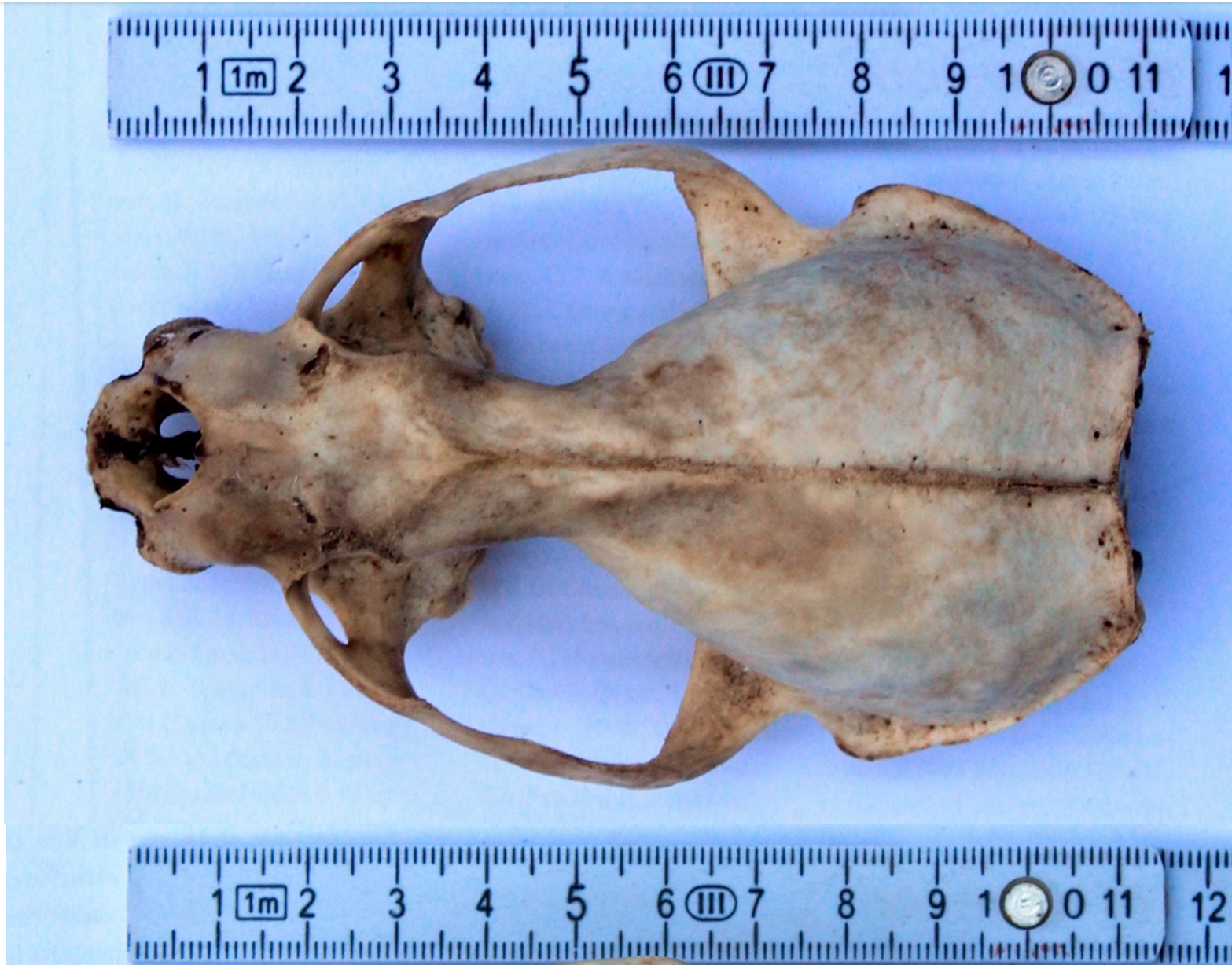
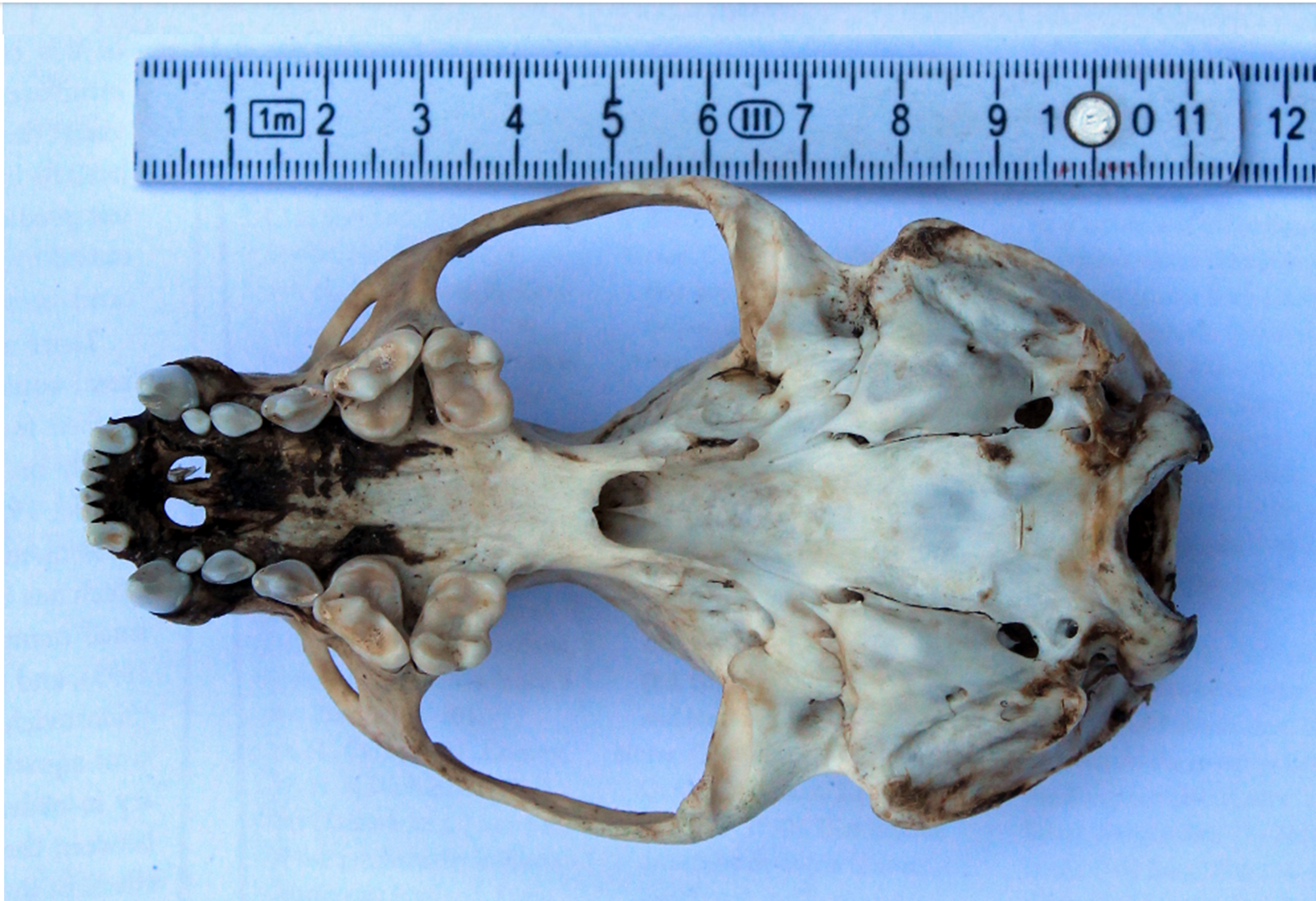
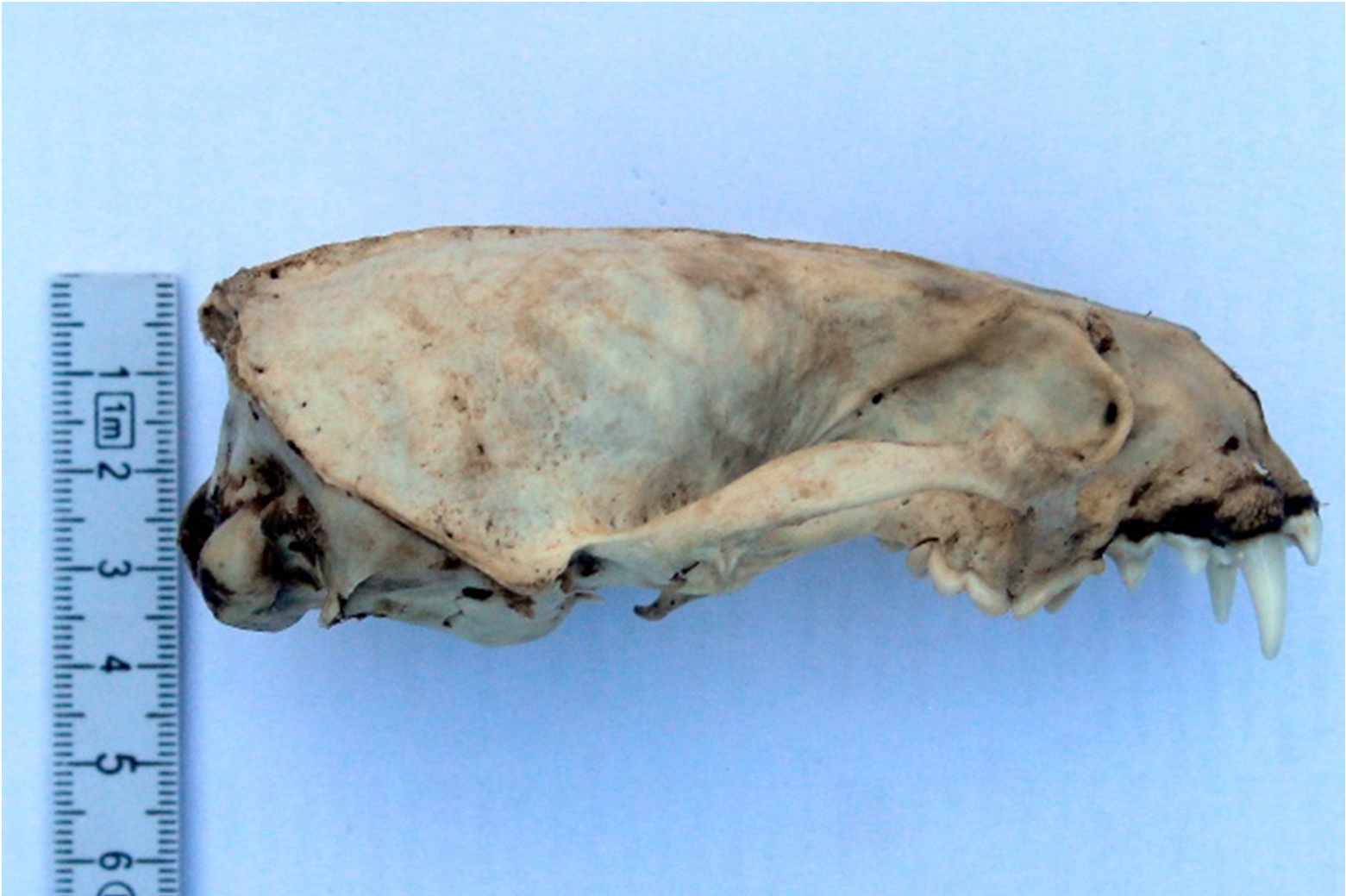
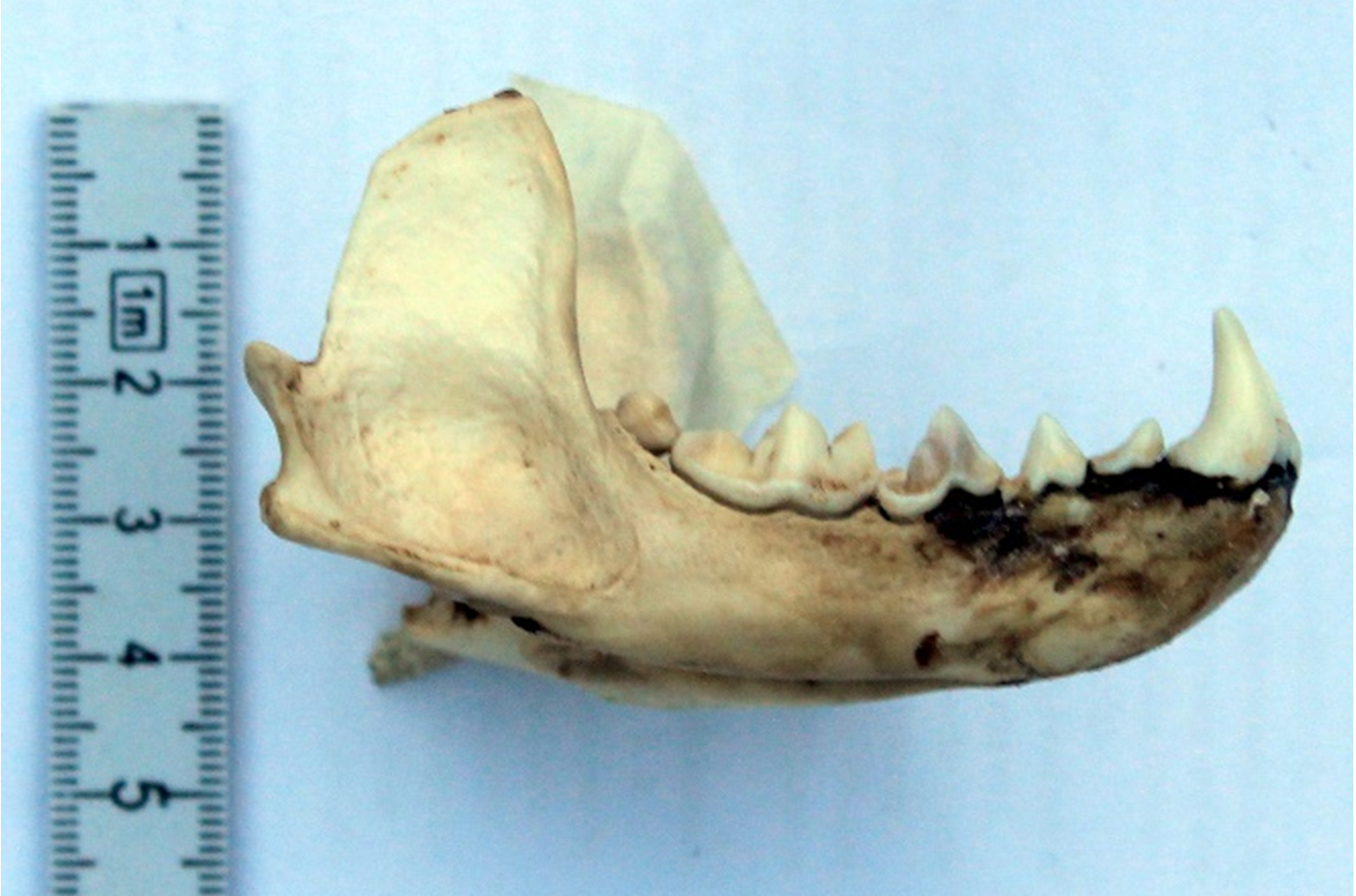
| Table 2: Measurement values of craniomandibular traits of skull | |
| Craniomandibular Traits | Measurement (mm) |
| CBL | 111 |
| ZB | 66 |
| POC | 17 |
| MB | 62 |
| PL | 61 |
| CAB | 25 |
| MPB | 35 |
| CH | 36 |
| CO | 65 |
| MO | 40 |
| MAT | 25 |
| MAM | 25 |
Of the Eurasian otter cranial morphology studies, selected craniomandibular traits are somewhat variable. Lynch and O’Sullivan (1993) had 11 craniomandibular traits; while Ansorge and Stubbe (1995) had 10 traits and Rasooli et al. (2007) had 6 craniomandibular traits in Eurasian otter skull study. Hwang and Larivière (2005) had 6 craniomandibular traits measurement in Smooth-coated otter skull study. Cranial morphology has been used in taxonomic studies of mammals (Lynch and O’Sullivan, 1993). But, the inconsistency in traits between the studies and mere cranial morphology study primarily in Smooth-coated otter skull have been a limiting factor for identification of otter species through cranial morphology. Of twelve craniomandibular traits of Eurasian otters have CBL and ZB as identifying traits (Lynch and O’Sullivan, 1993; Ansorge and Stubbe, 1995; Rasooli et al., 2007).
The measurements of this skull specimen of CBL (111mm) and ZB (66mm) match Eurasian otter skull values from other parts of the world. For example, CBL values in 26 male and 21 female Eurasian otter from Ireland ranged from 110.9-122.7 mm and 102.6-113.5mm respectively; and ZB values ranged from 66.6-76.5mm and 62.5-71.5mm respectively (Lynch and O’Sullivan, 1993). The CBL and ZB of the Roshi River skull show similar measurements to those in study by Ansorge and Stubbe (1995). CBL values in 102 male and 64 female Eurasian otters from Germany ranged from 106.1-124.3 mm and 104.1-121.0 mm respectively (Ansorge and Stubbe, 1995); and ZB values for 96 male and 58 female Eurasian otters, and ranged from 65.9-81.5 mm and 61.8-74.8 mm, respectively (Ansorge and Stubbe, 1995). Rosooli et al. (2007) measured CBL of 9 male and 12 female Eurasian otter in Iran ranged from 110.2-124.9 mm and 110.8-113.2mm respectively, and for ZB of 8 males and 9 female Eurasian otter, ZB values ranged from 71.6-81.2mm and 66.7-74.1 mm respectively (Rosooli et al., 2007).
The CBL and ZB value of the Roshi River skull specimen show similar values with the CBL and ZB value of female Smooth-coated otter by Hwang and Larivière (2005). However, the cranial morphology is different. The Smooth-coated otter has a high domed skull with the eyes set more forward and more widely spaced compared to the flat skull of Eurasian otters (Fig. 7) (Otterjoy, 2021). And the rostrum of the Smooth-coated otter is shorter (Hwang and Larivière, 2005) relative to the longer rostrum of the Eurasian otter (Fig. 8).

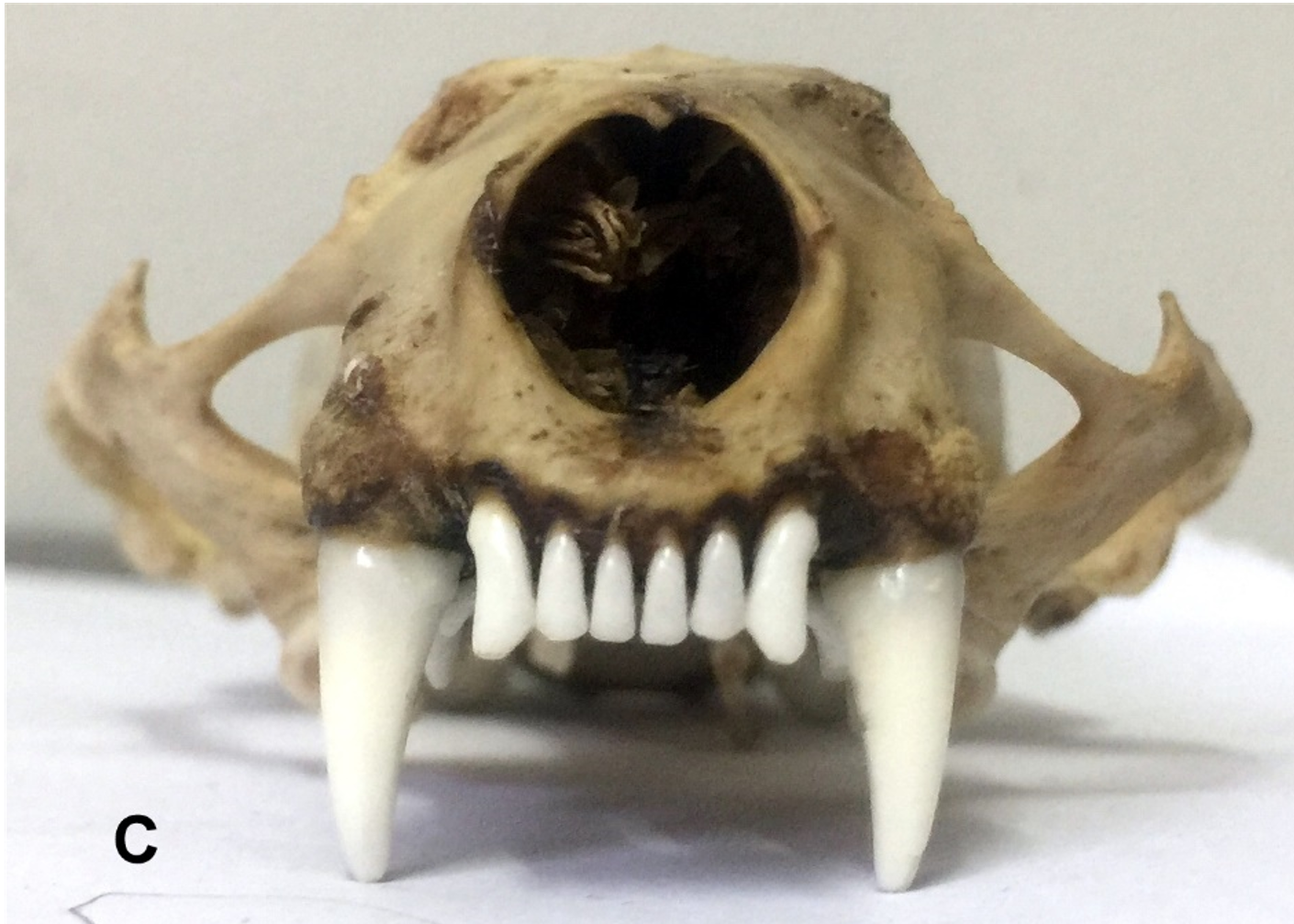
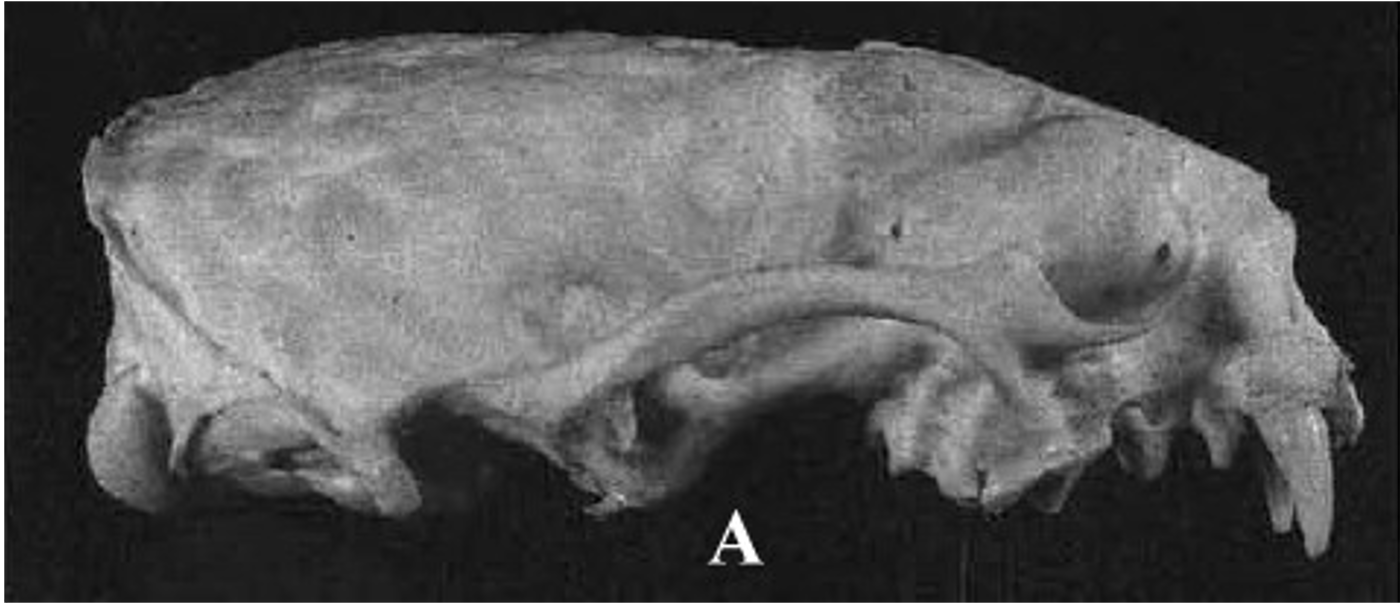
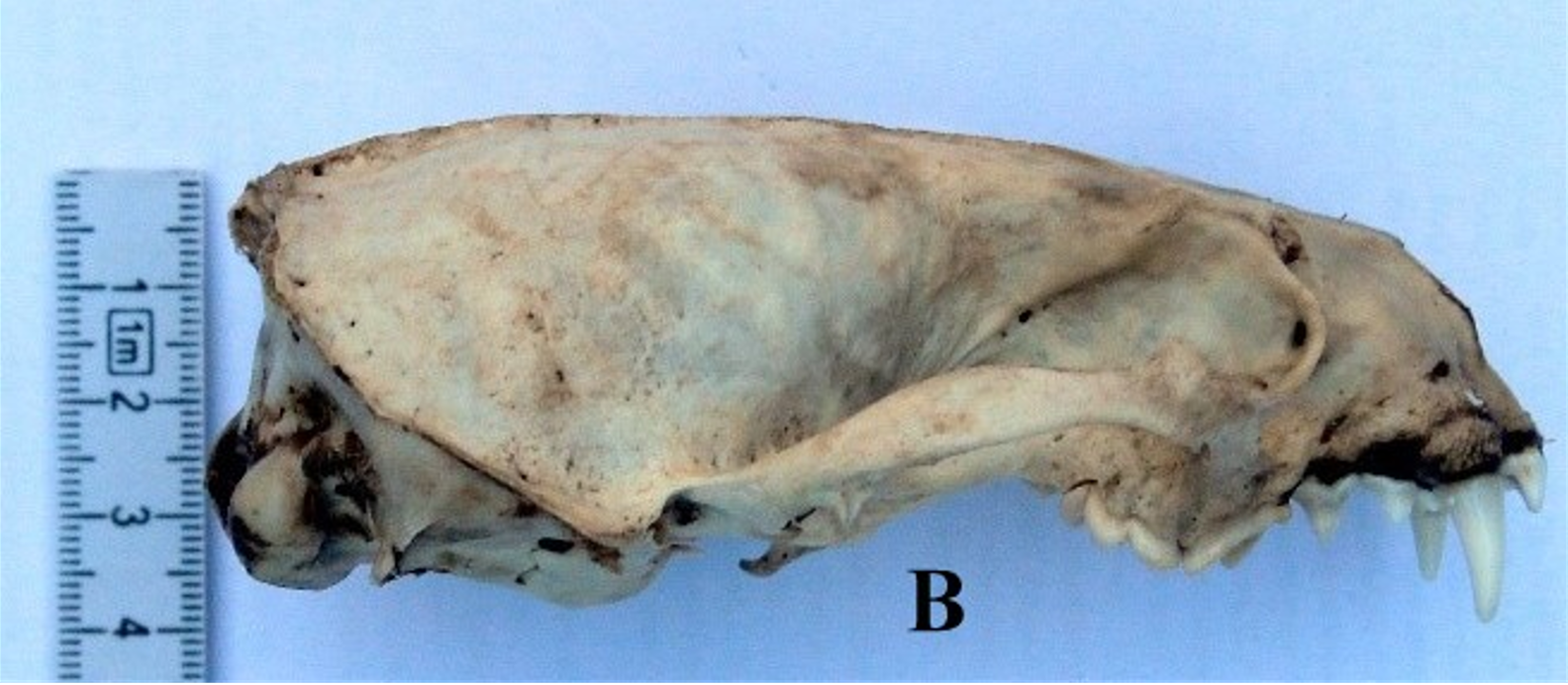
CONCLUSION
The camera trap images from the Barekot River, Jajarkot, photographs of Eurasian otter from the Tubang River, East Rukum and craniomandibular trait measurements of a skull specimen obtained in the Roshi River, Kavrepalanchok all confirm the continued presence of Eurasian otters in the hill streams in Nepal. Further study would elucidate the distribution of Eurasian otters in this region. A public awareness program for duck farmers and villagers along the Roshi River, including sensitization workshop for local conservation authorities, would help to conserve this rare species in Nepal.
Acknowledgements: We are grateful to the Department of Forest and Soil Conservation-Government of forest for permission to conduct study in East Rukum. We are grateful to duck farmers of the Roshi River for providing information and the skull specimen and Madan Khadka for providing information of otter presence in Tubang River, East Rukum. We thank Nicole Duplaix for identification of otter images, photographs and otter scat and IUCN Otter Specialist Group and Himalayan Otter Network, for financial support.
REFERENCES
Acharya, P.M., Gurung, J.B. (1994). A report on the status of Common Otter Lutra Lutra in Begnas and Rupa Lakes of Pokhara Valley. Tiger Paper Regional Quarterly Bulletin on Wildife and National Parks Management V. XXI: No. 2: 21-24.
Acharya P., Lamsal P. (2010). A survey for smooth-coated otter Lutrogale perspicillata on the river Narayani, Chitwan Nartional Park, Nepal. Hystrix It. J. Mamm., 21(2): 199-202.
Acharya, P., Rajbhandari, S.L. (2011). Status of Otters in Nepal. Report Submitted to IUCN/SSC Asian Secretariat, Sri Lanka.
Ansorge, H., Stubbe, M. (1995). Nonmetric skull divergence in the otter-assessing genetic insulation of population. IUCN Otter Spec. Group Bull. 11:17-28. https://www.iucnosgbull.org/Volume11/Ansorge_Stubbe_1995.html
Basnet, A., Bist, B. S., Ghimire, P., Acharya, P.M. (2020). Eurasian Otter (Lutra lutra): Exploring evidence in Nepal. IUCN Otter Spec. Group Bull. 37 (1): 29-37. https://www.iucnosgbull.org/Volume37/Basnet_et_al_2020.html
Bhandari, J., Bijaya, D.G.C. (2008). Preliminary survey and awareness for otter conservation in Rupa Lake, Pokhara, Nepal. Journal of Wetlands Ecology, 1(1/2): 2.
Bolton M. (1976). Lake Rara National Park Management Plan 1976-81. Project Working Document No. 3. HMG/UNDP/FAO Project: FAO/NEP/72/002. Kathmandu. 70.
Biodiversity Profile Project ( BPP) (1995). Enumeration of the Mammals of Nepal. Biodiversity Profiles Project. Technical Publication No. 6. Department of National Parks and Wildlife Conservation. Kathmandu. 86.
Hung, N., Law, C.J. (2016). Lutra lutra (Carnivora:Mustelidae). Mammalian Species, 48 (940): 109-122.
Hwang, Y.T., Larivière, S. (2005). Lutrogale perspicillata. Mammalian species, 786:1-4.
Karki, R., Talchabhadel, R., Aalto, J., Baidya, S.K. (2016). New climatic classification of Nepal. Theor Appl Climatol 125:799-808
Kafle, G. (2007). Status and conservation of Ramsar sites and associated biodiversity in Nepal with emphasis on Ghodaghodi Lake Area. A MSc. Thesis submitted to Institute of Forestry, Pokhara, Nepal.
Kafle, G. (2011). Otter Research and Conservation Project in Wetlands of High Hills, Nepal. A Research Report submitted to The Rufford Small Grants Foundation, United Kingdom. 9.
Kruuk, H. (1995). Wild otters: Predation and population. Oxford University Press, 123-124.
Law, C. J., Venkatram, V., Mehta, R. S. (2016). Sexual dimorphism in craniomandibular morphology of southern sea otters Enhydra lutris nereis. Journal of Mammology 97(6): 1764-1773.
Lynch, J.M., O’Sullivan, W.M. (1993). Cranial form and sexual dimorphism in the Irish otter Lutra lutra L. Biology and Environment: Proceedings of the Royal Irish Academy, 93b(2): 97-105.
Macdonald, S. (1990). Surveys. In: Foster-Turley, P., Macdonald, S.M., Mason, C.F. (Eds.). Otters: An Action Plan for their Conservation. IUCN/Otter Specialist Group, Gland. Pp. 8-10.
Melissen, A. (2000). Eurasian otter Lutra lutra. Husbandary guidelines for Lutra lutra.
Otterjoy (2021). Appearance and Anatomy of the Smooth-coated otter. http://www.otterjoy.com/otterinfo/lutrogale/perspicillata/perspicillata_anatomy.html
Rasooli, P., Kiabi, B.H., Abdoli, A. (2007). On the status and biology of the European Otter, Lutra lutra (Carnivora: Mustelidae), in Iran. Zoology in the Middle East, 41: 25-29.
Savage, M., Shrestha, M.B. (2018). The illegal trade in otter pelts in Nepal. Traffic Bulletin, 30(2): 59-61.
Shrestha, T.K. (1997). Mammals of Nepal with reference to those of India, Bangladesh, Bhutan and Pakistan. Mandela Book. Point, Nepal. 387 pp.
Yonzon, P.B. (1996). Status of Wildlife in Kanchenjunga Region. A Reconnaissance Report Series 23. Kathmandu and WWF Nepal.
Yonzon, P.B. (1998). Baseline information on wildlife of the west Seti River Valley with emphasis on birds and mammals. A report to the West Seti Hydro-Electric project. SMEC Ltd.
Résumé: Première Évidence de la Presence de la Loutre Eurasienne au Népal en Trente Ans
Cette étude présente la première preuve de la présence de la loutre eurasienne au Népal depuis 1991. Des images de pièges photographiques de la rivière Barekot dans le district de Jajarkot, des images photographiques de la rivière Tubang dans le district de l’Est Rukum et le crâne d'une loutre morte sont présentés comme documents. Douze mesures de traits cranio-mandibulaires ont été effectuées sur un spécimen de crâne trouvé dans la rivière Roshi : la longueur condylo-basale (CBL) du crâne de 111 mm, et la largeur zygomatique (ZB) de 66 mm, permettent d’identifier le spécimen comme une loutre eurasienne (Lutra lutra). Les mesures CBL et ZB, crâne de forme plate et rostre plus long, étaient similaires à celles obtenues par les études morphométriques de la loutre eurasienne dans d'autres zones de son aire de répartition.
Revenez au dessus
Resumen: Primera Evidencia de Nutria Eurasiática dn Nepal dn Tres Décadas
Este estudio presenta la primera evidencia de presencia de Nutria Eurasiática en Nepal desde 1991. Presentamos como documentación, imágenes de cámara-trampa el Río Barekot en el Distrito Jajarkot, imágenes fotográficas del Río Tubang en el Distrito Rukum Oriental, y el cráneo de una nutria muerta. Llevamos a cabo doce mediciones de rasgos craniomandibulares en un cráneo encontrado en el Río Roshi: la longitud condilobasal (LCB) de la caja craneana, de 111 mm, y el ancho zigomático (AZ) de 66 mm, identifican al espécimen como una nutria Eurasiática (Lutra lutra). Las medidas LCB y AZ, el cráneo de forma achatada y el rostrum más largo, fueron similares a lo obtenido por estudios morfométricos de la nutria Eurasiática en otras porciones de su distribución.
Vuelva a la tapa










